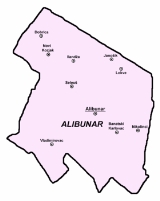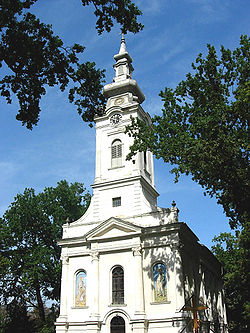
Alibunar
Encyclopedia


South Banat District
South Banat District is a northeastern district of Serbia with the seat of the district in Pančevo. It borders Romania to the east. The district lies in the region of Banat, in the autonomous province of Vojvodina...
of Vojvodina
Vojvodina
Vojvodina, officially called Autonomous Province of Vojvodina is an autonomous province of Serbia. Its capital and largest city is Novi Sad...
, Serbia
Serbia
Serbia , officially the Republic of Serbia , is a landlocked country located at the crossroads of Central and Southeast Europe, covering the southern part of the Carpathian basin and the central part of the Balkans...
. Alibunar town has a population of 3,402, and Alibunar municipality 22,856.
Name
In SerbianSerbian language
Serbian is a form of Serbo-Croatian, a South Slavic language, spoken by Serbs in Serbia, Bosnia and Herzegovina, Montenegro, Croatia and neighbouring countries....
, the town is known as Alibunar or Алибунар, in Romanian
Romanian language
Romanian Romanian Romanian (or Daco-Romanian; obsolete spellings Rumanian, Roumanian; self-designation: română, limba română ("the Romanian language") or românește (lit. "in Romanian") is a Romance language spoken by around 24 to 28 million people, primarily in Romania and Moldova...
as Alibunar, in German
German language
German is a West Germanic language, related to and classified alongside English and Dutch. With an estimated 90 – 98 million native speakers, German is one of the world's major languages and is the most widely-spoken first language in the European Union....
as Alisbrunn, in Hungarian
Hungarian language
Hungarian is a Uralic language, part of the Ugric group. With some 14 million speakers, it is one of the most widely spoken non-Indo-European languages in Europe....
as Alibunár, and in Turkish
Turkish language
Turkish is a language spoken as a native language by over 83 million people worldwide, making it the most commonly spoken of the Turkic languages. Its speakers are located predominantly in Turkey and Northern Cyprus with smaller groups in Iraq, Greece, Bulgaria, the Republic of Macedonia, Kosovo,...
as Alipınar.
The name of the town derived from the Serbian word "bunar" ("well" in English) and Muslim/Turkish personal name "Ali". According to the local legend, Alibunar was named after Ali-paša (Ali-pasha), who had a cattle and a well at this place. Even today, there is a well in the town which is known as "Ali-pašin bunar" ("well of Ali-paša"). Before the Ottoman rule, Alibunar was known as "Krsturnica".
Inhabited places
Alibunar municipality encompasses of town of Alibunar, town of Banatski KarlovacBanatski Karlovac
Banatski Karlovac is a town located in the Alibunar municipality, in the South Banat District of Serbia. It is situated in the Autonomous Province of Vojvodina. The town has a Serb ethnic majority and its population numbering 5,820 people...
, and following villages:
- DobricaDobricaDobrica is a village in Serbia. It is situated in the Alibunar municipality, in the South Banat District, Vojvodina province. The village has a Serb ethnic majority and its population numbering 1,344 people .-Name:...
- Novi KozjakNovi KozjakNovi Kozjak is a village in northern Serbia. It is situated in the Alibunar municipality, in the South Banat District, Vojvodina province...
- IlandžaIlandžaIlandža is a village in Serbia. It is situated in the Alibunar municipality, in the South Banat District, Vojvodina province. The village has a Serb ethnic majority and its population is 1,727 .-Name:...
- SeleušSeleušSeleuš or Seleuş is a village in Serbia. It is situated in the Alibunar municipality, in the South Banat District, Vojvodina province...
- VladimirovacVladimirovacVladimirovac is a village in Serbia. It is situated in the Alibunar municipality, in the South Banat District, Vojvodina province...
- JanošikJanošikJanošik is a village in Serbia. It is situated in the municipality of Alibunar, in the South Banat District, in the province of Vojvodina. The village has a Slovak ethnic majority and its population numbers 1,171 people .-Name:The current name of the village is of Slovak origin...
- LokveLokveLokve is a village in Serbia. It is situated in the Alibunar municipality, in the South Banat District, Vojvodina province...
- NikolinciNikolinciNikolinci is a village in Serbia. It is situated in the Alibunar municipality, in the South Banat District, Vojvodina province. The village has a Romanian ethnic majority and its population is 1,240 ....
History
In this area, settlements existed in Neolith, Bronze Age and Roman times. However, settlement appeared in historical sources in the 16th century. First recorded name of the settlement was Alijina Voda ("the water of Alija"), presumably named after its Muslim citizen Alija or Ali-paša, who had a house with stone well ("bunar" in Serbian) in the center of the settlement (hence the current name Alibunar or "the well of Ali"). After Ottomans were expelled from this region (in 1717), the settlement had 32 houses. In 1764, settlement was included into Illyrian (Serbian) regiment of Banatian Military Frontier, but in the next year, it was transferred to German regiment of this frontier. Before the inclusion into military frontier, Alibunar had ethnic Serb population, but after it became part of the frontier, 130 mostly Romanian and some 20-30 German families settled in this place. Serbs remained to live in older part of the settlement, Germans settled in its central parts and Romanians in northern parts. Serbian Orthodox church in the settlement was built in 1796.Source: Stevan Kovačević, Gradovi Srbije u slici i reči, Beograd, 2010.
Historical population
Population of the town in different censuses:- 1948: 3,616
- 1953: 3,811
- 1961: 3,705
- 1971: 3,951
- 1981: 3,803
- 1991: 3,738
- 2002: 3,431
Ethnic groups (2002 census)
The population of the Alibunar municipality:- SerbsSerbsThe Serbs are a South Slavic ethnic group of the Balkans and southern Central Europe. Serbs are located mainly in Serbia, Montenegro and Bosnia and Herzegovina, and form a sizable minority in Croatia, the Republic of Macedonia and Slovenia. Likewise, Serbs are an officially recognized minority in...
= 13,680 (59.59%) - RomaniansRomaniansThe Romanians are an ethnic group native to Romania, who speak Romanian; they are the majority inhabitants of Romania....
= 6,076 (26.47%) - SlovaksSlovaksThe Slovaks, Slovak people, or Slovakians are a West Slavic people that primarily inhabit Slovakia and speak the Slovak language, which is closely related to the Czech language.Most Slovaks today live within the borders of the independent Slovakia...
= 1,195 (5.2%) - Roma = 657 (2.86%)
- Hungarians = 309 (1.34%)
Settlements with a Serb ethnic majority are: Alibunar, Banatski Karlovac, Vladimirovac, Dobrica, Ilandža, and Novi Kozjak. The settlement with a Slovak ethnic majority is Janošik. The settlements with Romanian ethnic majority are: Lokve and Nikolinci. The ethnically mixed settlement with a relative Romanian majority is Seleuš.
The municipality of Alibunar contains the biggest ethnic Romanian community in Vojvodina.
The population of the Alibunar town:
- SerbsSerbsThe Serbs are a South Slavic ethnic group of the Balkans and southern Central Europe. Serbs are located mainly in Serbia, Montenegro and Bosnia and Herzegovina, and form a sizable minority in Croatia, the Republic of Macedonia and Slovenia. Likewise, Serbs are an officially recognized minority in...
= 2,052 (59.81%) - RomaniansRomaniansThe Romanians are an ethnic group native to Romania, who speak Romanian; they are the majority inhabitants of Romania....
= 960 (27.98%) - Roma = 87 (2.54%)
- Hungarians = 61 (1.78%)
- SlovaksSlovaksThe Slovaks, Slovak people, or Slovakians are a West Slavic people that primarily inhabit Slovakia and speak the Slovak language, which is closely related to the Czech language.Most Slovaks today live within the borders of the independent Slovakia...
= 46 (1.34%) - MacedoniansMacedonians (ethnic group)The Macedonians also referred to as Macedonian Slavs: "... the term Slavomacedonian was introduced and was accepted by the community itself, which at the time had a much more widespread non-Greek Macedonian ethnic consciousness...
= 43 (1.25%) - YugoslavsYugoslavsYugoslavs is a national designation used by a minority of South Slavs across the countries of the former Yugoslavia and in the diaspora...
= 42 (1.22%)

